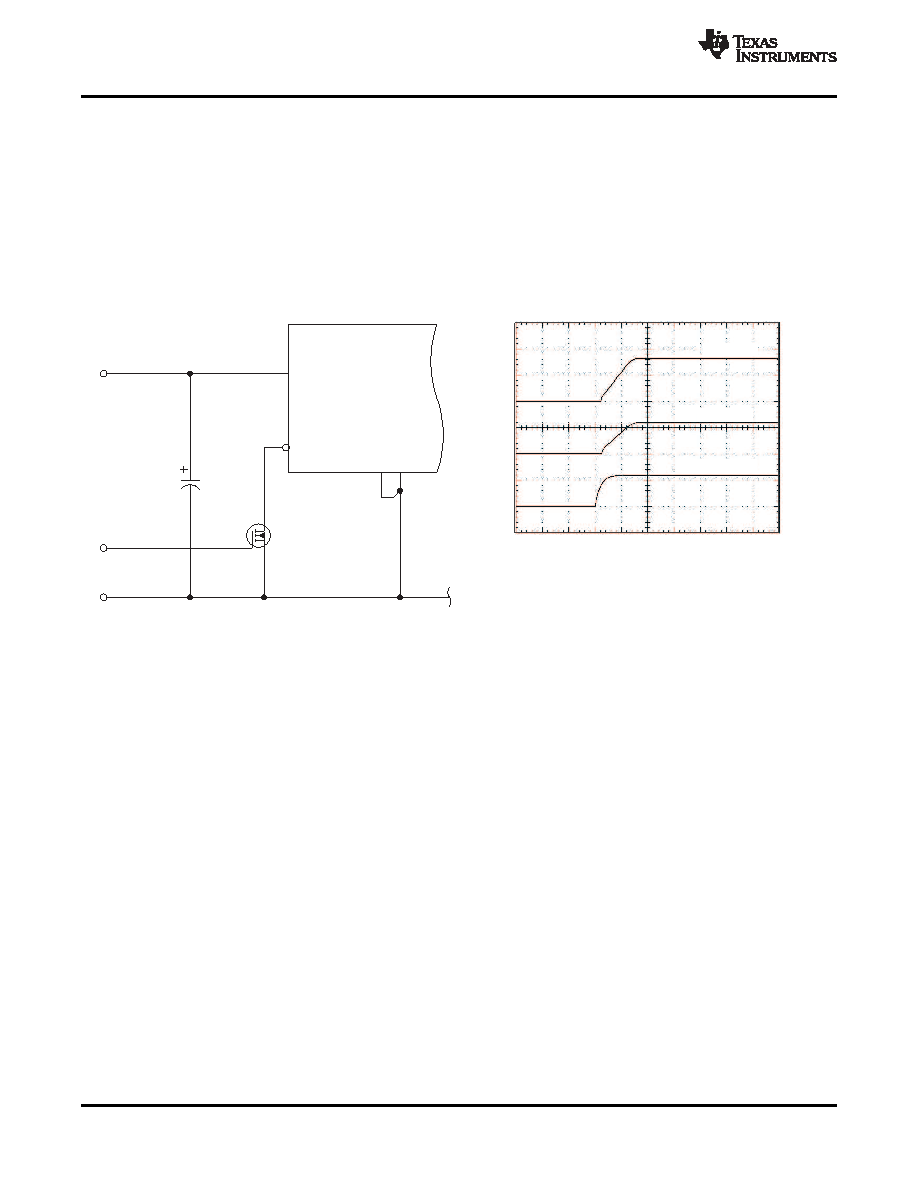- 您現(xiàn)在的位置:買賣IC網(wǎng) > PDF目錄69253 > PTH08T210WAS (TEXAS INSTRUMENTS INC) 1-OUTPUT DC-DC REG PWR SUPPLY MODULE PDF資料下載
參數(shù)資料
| 型號: | PTH08T210WAS |
| 廠商: | TEXAS INSTRUMENTS INC |
| 元件分類: | 電源模塊 |
| 英文描述: | 1-OUTPUT DC-DC REG PWR SUPPLY MODULE |
| 封裝: | DIP-14 |
| 文件頁數(shù): | 15/31頁 |
| 文件大小: | 1235K |
| 代理商: | PTH08T210WAS |
第1頁第2頁第3頁第4頁第5頁第6頁第7頁第8頁第9頁第10頁第11頁第12頁第13頁第14頁當(dāng)前第15頁第16頁第17頁第18頁第19頁第20頁第21頁第22頁第23頁第24頁第25頁第26頁第27頁第28頁第29頁第30頁第31頁

Output On/Off Inhibit
t Time 10ms/div
VO (2V/div)
II (5 A/div)
VINH (2V/div)
1 Inhibit/
UVLO
GND
2, 6
GND
3,4
7,8
VI
1 = Inhibit
Q1
BSS 138
PTH08T210W
CI
Overcurrent Protection
SLTS262I – OCTOBER 2005 – REVISED MARCH 2009 ................................................................................................................................................... www.ti.com
For applications requiring output voltage on/off control, the PTH08T210W incorporates an output Inhibit control
pin. The inhibit feature can be used wherever there is a requirement for the output voltage from the regulator to
be turned off.
The power modules function normally when the Inhibit pin is left open-circuit, providing a regulated output
whenever a valid source voltage is connected to VI with respect to GND. The Inhibit function becomes active
when the input voltage is greater than 4.25 V.
Figure 22 shows the typical application of the inhibit function. Note the discrete transistor (Q1). The Inhibit input
has its own internal pull-up to a potential of 5 V. The input is not compatible with TTL logic devices and should
not be tied to VI. An open-collector (or open-drain) discrete transistor is recommended for control.
Figure 22. On/Off Inhibit Control Circuit
Figure 23. Power-Up Response from Inhibit Control
Turning Q1 on applies a low voltage to the Inhibit control pin and disables the output of the module. If Q1 is then
turned off, the module executes a soft-start power-up sequence. A regulated output voltage is produced within 25
ms. Figure 23 shows the typical rise in both the output voltage and input current, following the turn-off of Q1. The
turn off of Q1 corresponds to the rise in the waveform, Q1 VDS. The waveforms were measured with a 20-A
constant current load.
NOTE: When applying a low voltage (
≤0.6 V) to the Inhibit control pin to turn off the module, the low side
FET will immediately discharge any capacitance on the output bus. Depending on the amount and type
of capacitors, this may induce a negative voltage transient that can momentarily go below GND potential.
If turn-off control is desired, the Auto-Track pin can be used to the control ramp up and ramp down of
the output voltage.
For protection against load faults, all modules incorporate output overcurrent protection. Applying a load that
exceeds the regulator's overcurrent threshold causes the regulated output to shut down. Following shutdown, a
module periodically attempts to recover by initiating a soft-start power-up. This is described as a hiccup mode of
operation, whereby the module continues in a cycle of successive shutdown and power up until the load fault is
removed. During this period, the average current flowing into the fault is significantly reduced. Once the fault is
removed, the module automatically recovers and returns to normal operation.
22
Copyright 2005–2009, Texas Instruments Incorporated
Product Folder Link(s): PTH08T210W
相關(guān)PDF資料 |
PDF描述 |
|---|---|
| PTH08T210WAD | 1-OUTPUT DC-DC REG PWR SUPPLY MODULE |
| PTH08T210WAST | 1-OUTPUT DC-DC REG PWR SUPPLY MODULE |
| PTH08T221WAZ | 1-OUTPUT DC-DC REG PWR SUPPLY MODULE |
| PTH08T220WAH | 1-OUTPUT DC-DC REG PWR SUPPLY MODULE |
| PTH08T221WAD | 1-OUTPUT DC-DC REG PWR SUPPLY MODULE |
相關(guān)代理商/技術(shù)參數(shù) |
參數(shù)描述 |
|---|---|
| PTH08T210WAST | 功能描述:DC/DC轉(zhuǎn)換器 30A 5.5-14V-Inp Wide-Out Adj Pwr Mdl RoHS:否 制造商:Murata 產(chǎn)品: 輸出功率: 輸入電壓范圍:3.6 V to 5.5 V 輸入電壓(標(biāo)稱): 輸出端數(shù)量:1 輸出電壓(通道 1):3.3 V 輸出電流(通道 1):600 mA 輸出電壓(通道 2): 輸出電流(通道 2): 安裝風(fēng)格:SMD/SMT 封裝 / 箱體尺寸: |
| PTH08T210WAZ | 功能描述:DC/DC轉(zhuǎn)換器 30A 5.5-14V-Inp Wide-Out Adj Pwr Mdl RoHS:否 制造商:Murata 產(chǎn)品: 輸出功率: 輸入電壓范圍:3.6 V to 5.5 V 輸入電壓(標(biāo)稱): 輸出端數(shù)量:1 輸出電壓(通道 1):3.3 V 輸出電流(通道 1):600 mA 輸出電壓(通道 2): 輸出電流(通道 2): 安裝風(fēng)格:SMD/SMT 封裝 / 箱體尺寸: |
| PTH08T210WAZT | 功能描述:DC/DC轉(zhuǎn)換器 30A 5.5-14V-Inp Wide-Out Adj Pwr Mdl RoHS:否 制造商:Murata 產(chǎn)品: 輸出功率: 輸入電壓范圍:3.6 V to 5.5 V 輸入電壓(標(biāo)稱): 輸出端數(shù)量:1 輸出電壓(通道 1):3.3 V 輸出電流(通道 1):600 mA 輸出電壓(通道 2): 輸出電流(通道 2): 安裝風(fēng)格:SMD/SMT 封裝 / 箱體尺寸: |
| PTH08T212WAZ | 制造商:Texas Instruments 功能描述: |
| PTH08T220W | 制造商:TI 制造商全稱:Texas Instruments 功能描述:16-A, 4.5-V to 14-V INPUT, NON-ISOLATED, WIDE-OUTPUT, ADJUSTABLE POWER MODULE WITH TurboTrans |
發(fā)布緊急采購,3分鐘左右您將得到回復(fù)。